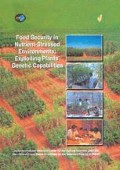Abstract
One hundred genotypes each of sorghum and pigeonpea were screened for their adaptation to soils low in nitrogen (N) and phosphorus (P) on an Alfisol and a Vertisol. The tested genotypes were classified by growth duration, growing habit, plant shape, germplasm collection site, and end use, and results were analyzed by classified groups. A wide range of genetic variation in grain and dry matter yields was observed. Dry matter yield depended on growth duration. For sorghum to attain maximum dry matter yield, growth duration should exceed 80 days, and to attain the maximum growth rate, a main stem longer than 250 cm, large and thin leaves (mean leaf area over 320 cm2, specific leaf area (SLA) larger than 250 cm2 g), and a leaf/stem weight ratio below 0.6 are required. Total accumulated plant N was positively correlated to dry matter yield but not to N-use efficiency of accumulated N. Results suggest that the ability of roots to absorb soil-N was comparatively more important for biomass productivity under low-N conditions than N-use efficiency. Biomass production in the growth stage and at harvest were not positively correlated, because some hybrids and forage varieties grew vigorously in the late growth stage. This suggests that improvement of growth activities in both early- and late-maturing types should be integrated when breeding for adaptation to low-N soils. Such morphological characteristics as large thin leaves, long main stems, and low leaf/stem weight are required for future ideotypes of sorghum and pigeonpea adapted to low-N and low-P conditions.
Access this chapter
Tax calculation will be finalised at checkout
Purchases are for personal use only
Preview
Unable to display preview. Download preview PDF.
References
Ae N, Arihara J and Okada K 1991 Phosphorus uptake mechanisms of pigeonpea grown in Alfisols and Vetisols. In Phosphorus nutrition of Grain Legumes in the Semi-Arid Tropics. Eds. C. Johansen, K K Lee and K L Sarawat. pp 91–104, International Crops Research Institute for the Semi-Arid Tropics (ICRISAT), Patancheru, Andhra Pradesh, India.
Buzzell R I and Buttery B R 1977 Soybean harvest index in hillplots. Crop Sci. 17, 968–970.
Franca G E 1981 Differences in dry-matter yield and the uptake, distribution, and use of nitrogen by sorghum genotypes. Ph.D. Thesis, Univ. of Nebraska, Lincoln, Nebraska, U S A. Diss. Abstr. 41, 4018B.
Gabelman W H and Gerloff G C 1983 The search and interpretation of genetic controls that enhance plant growth under deficiency levels of a macronutrient. Plant Soil 72, 335–350.
Kawano K 1986 Yield breeding under limited-input condition. In Proceeding of the 28th symposium of Jap. Breeding Sci. Soc. pp 4–10. Tokyo, Japan.
Kawano K, Gonzales H and Lucena M 1974 Intraspecific competition, competition with weeds, and spacing response in rice. Crop Sci. 14, 841–845.
Koyama T, Chammek C and Snitwongse P 1973 Varietal differences of Thai rice in the irresistance to phosphorus deficiency. Tech. Bull. TARC No. 4, 1–32.
Lafitte H R and Edmeades G O 1994 Improvement for tolerance to low soil nitrogen in tropical maize I. Selection criteria. Field Crop Res. 39, 1–14.
Maraville J W, Clark R and Ross W M 1980 Nitrogen efficiency in grain sorghum. J. Plant Nutr. 2, 577–589.
Muchow R C 1988 Effect of nitrogen supply on the comparative productivity of maize and sorghum in a semi-arid tropical environment. III. Grain yield and nitrogen accumulation. Field Crops Res. 18, 31–34.
Muchow R C and Davis 1988 Effect of nitrogen supply on the comparative productivity of maize and sorghum in a semi-arid tropical environment. II. Radiation interception and biomass accumulation. Field Crops Res. 18, 17–30.
Schinkel B and Mechelke W 1990 A method to estimate the prospect of specific breeding for nutrient efficiency. In Genetic aspects of plant mineral nutrition. Eds. N El Bassam, M Dambroth and B C Loughman. pp 449–456, Kruwer Academic Publishers, Dordrecht, The Netherlands.
Sheldrake A R and Narayana A 1979 Growth, development and nutrient uptake in pigeonpea (Cajanus cajan). J. Agric. Sci. Camb 92, 513–526.
Spanakakis A and Viedt A 1990 Performance of winter wheat cultivars under reduced nitrogen conditions. In Genetic Aspects of Plant Mineral Nutrition. Eds. N El Bassam, M Dambroth and B C Loughman. pp 465–473, Kluwer Academic Publishers, Dordrecht, the Netherlands.
Tsunoda S 1959 A developmental analysis of yielding ability in varieties of field crops. II. The assimilation system of plants as affected by the form, direction and arrangement of single leaves. Jap. J. Breeding 9, 237–244.
Tsunoda S 1962 A developmental analysis of yielding ability in varieties of field crops. IV. Quantitative and spatial development of the stem-system. Jap. J. Breeding 12, 49–56.
Yamaguchi J 1974 Varietal traits limiting the grain yield of tropical maize. IV. Plant traits and productivity of tropical varieties. Soil Sci. Plant Nutr. 20, 287–304.
Author information
Authors and Affiliations
Editor information
Rights and permissions
Copyright information
© 2002 Springer Science+Business Media Dordrecht
About this chapter
Cite this chapter
Nakano, H., Adu-Gyamfi, J.J., Nakamura, T. (2002). Genetic adaptation of crop plants to low-nutrient environments: morphological and ecophysiological characteristics of adaptation. In: Adu-Gyamfi, J.J. (eds) Food Security in Nutrient-Stressed Environments: Exploiting Plants’ Genetic Capabilities. Developments in Plant and Soil Sciences, vol 95. Springer, Dordrecht. https://doi.org/10.1007/978-94-017-1570-6_8
Download citation
DOI: https://doi.org/10.1007/978-94-017-1570-6_8
Publisher Name: Springer, Dordrecht
Print ISBN: 978-90-481-6013-6
Online ISBN: 978-94-017-1570-6
eBook Packages: Springer Book Archive

